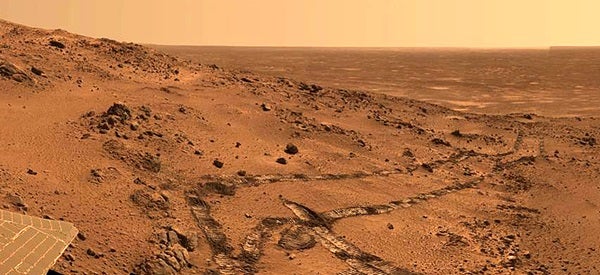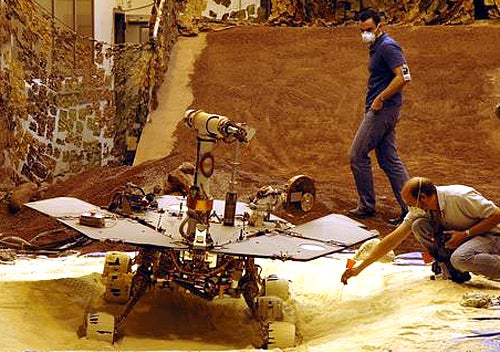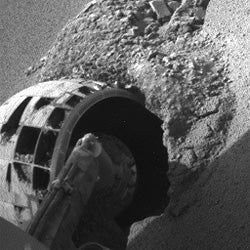When rovers Spirit and Opportunity landed on Mars in late January 2004, it quickly became clear luck was on Opportunity’s side. The rover not only made a hole-in-one landing in Eagle Crater on the Meridiani plains, but the crater wall held an outcrop of layered bedrock — exactly what scientists had hoped to locate. Opportunity analyzed this layer for nearly 2 months, eventually finding physical and chemical evidence the bedrock’s layers had formed in a shallow ancient sea.
At Gusev Crater, on the opposite side of Mars, Spirit found little more than volcanic rock after exploring the Red Planet for more than a year, trekking 2 miles from its landing site and climbing into the Columbia Hills.
Now, however, the rovers’ luck has turned. Spirit has finally located outcrops of layered terrain in the Columbia Hills, while, for the past 3 weeks, Opportunity has been struggling to make its way through soft sand.
“In the last few weeks, we have gone from a state of confusion about the geology of the Columbia Hills to having a real stratigraphic sequence and a powerful working hypothesis for the history of these layers,” Squyres says.
For several months, Spirit climbed a flank of Husband Hill, the tallest in the Columbia range, but the hill’s slope closely matched the angle of underlying rock layers, making layering there difficult to detect. Then, on February 24, Spirit reached a vista dubbed Larry’s Lookout and continued its uphill climb.
“That was the critical moment, when it all began falling into place,” Squyres explains. “Looking back downhill, you can see the layering, and it suddenly starts to make sense.”
Spirit has been examining a series of outcrops called Methuselah, Jibsheet, and Larry’s Outcrop. Some of the rocks contain ilmenite, a titanium-iron mineral formed when molten rock solidifies and one Spirit has not detected before. “Its occurrence is evidence for diversity in the volcanic rocks in the Gusev region,” says Dick Morris, a rover science-team member at NASA’s Johnson Space Center, Houston.
Rocks from different layers share compositional traits, high in titanium, and low in chromium, which suggest a shared origin, but the degree to which water exposure or other processes have chemically altered minerals varies greatly between outcrops.
Surface textures also vary. At Methuselah, Spirit’s microscopic imager revealed finely layered rocks. At Jibsheet, rocks formed from bulbous grains packed together. Rocks at Larry’s Outcrop are massive and show little fine-scale structure.
“Our best hypothesis is we’re looking at a stack of ash or debris that was explosively erupted from volcanoes and settled down in different ways,” Squyres explains. “We can’t fully rule out the possibility the debris was generated in impact explosions instead of volcanic ones. But we can say, once upon a time, Gusev was a pretty violent place. Big, explosive events were happening, and there was a lot of water around.”
Controllers continue to help Opportunity make slow progress across the sandy ripple that bogs it down. The rover has traversed just 11 inches since April 26. “If Opportunity gets free, its next task will be examining the site to give the rover team a better understanding of how this ripple differs from dozens Opportunity easily crossed,” says Jim Erickson, rover project manager at NASA’s Jet Propulsion Laboratory, Pasadena, California.












